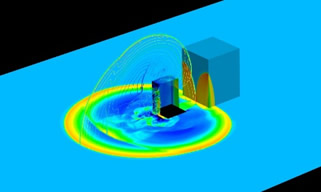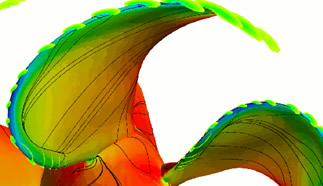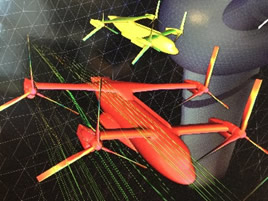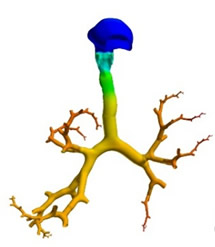Energetics
Dr. Xiao Wang and her team of computational engineers at CAVS have conducted research on both traditional CFD simulations, such as aircraft, turbomachinery, and marine propeller, and novel CFD applications of biosystem, including flows of human lung airway and aortic coarctation. Research highlights include:
Blast Loadings in Urban Environment
Detailed blast propagation and evolution through multiple structures representing an urban environment were simulated using Loci/BLAST. Both wave reflection and interaction between structures and blast loadings on structures were captured with good agreement against experiment.

Blast wave propagation and diffraction

Blade leading-edge flow separation resolved by TSM modeling
Marine-Propeller Performance
Simulations of a marine propeller are performed using a transition-sensitive turbulence model (TSM) to better resolve the propeller flow characteristics. Computational results compared with water-tunnel and open-water experimental data showed that the applied transition-sensitive turbulence model is better able to resolve blade-surface stress, flow separations, and tip-vortex originations. Consequently, this will improve the prediction accuracy in propeller performance, especially under high-load conditions.
Simulation and Analysis of Quad Tiltrotor Aircraft
Aerodynamic and vibratory loads of Quad Tiltrotor are investigated in support of conceptual vehicle design of the U.S. Army Joint Heavy Lift rotorcraft program.

Pressure contour of quad tiltrotor in airplane mode

Airway wall pressure during exhalation
Biological System Simulations
Human lung simulations adopted an efficient physiology-based modeling of large-scale lung airways on reduced geometry, using resistive airway model and truncated boundary treatment. A patient-specific non-uniform pressure outlet boundary condition was developed in unsteady simulations of cyclic breathing to investigate airway flow patterns of both healthy and diseased lungs, specifically with emphysema or interstitial fibrosis.
Simulation of blood analog flow through a patient-specific aortic coarctation revealed a slower flow region near the wall downstream the coarctation, which helps to explain that bacteria are more likely to be trapped to the aorta wall in this area, especially under stress condition, such as exercise.
References
- Wang, X., Remotigue, M., Arnoldus, Q., Janus, M., Luke, E., Thompson, D., Weed, R., and Bessette, G., High-fidelity simulations of blast loadings in urban environments using an overset meshing strategy, Shock Waves, May 2017, Vol. 27, pp 409-422.
- Wang X, & Walters K, 2012, Computational Analysis of Marine-Propeller Performance Using Transition-Sensitive Turbulence Modeling. ASME Journal of Fluids Engineering, July 2012, Vol.134/071107-1.
- Wang X, Walters DK, Burgreen GW, & Thompson DS, 2015, Cyclic Breathing Simulations: Pressure Outlet Boundary Conditions Coupled with Resistance & Compliance. Proceedings of the ASME-JSME_KSME Joint Fluids Engineering Conference 2015; July 2015, Seoul, Korea.
- Wang X, Walters DK, Burgreen GW, & Thompson D. Traditional CFD Boundary Conditions Applied to Blood Analog Flow through a Patient-Specific Aortic Coarctation. Statistical Atlases and Computational Models of the Heart. Imaging and Modelling Challenges. Lecture Notes in Computer Science 2014, 8330:118-125.
